Wenatchee is located in North Central Washington and is the largest city in and the county seat of Chelan County.
The population was 29,898 at the 2008 census. 35,508 people lived here as of 2020. Located at the confluence of the Wenatchee and Columbia rivers near the eastern foothills of the Cascade Range, Wenatchee lies on the western side of the Columbia River, across from the city of East Wenatchee. The Columbia River forms the boundary between Chelan and Douglas County. Wenatchee is the principal city of the 'Wenatchee–East Wenatchee, Washington Metropolitan Statistical Area', which encompasses all of Chelan and Douglas counties. However, the 'Wenatchee Area' generally refers to the land between Rocky Reach and Rock Island Dam on both banks of the Columbia, which includes East Wenatchee, Rock Island, and Malaga.
The city was named for the nearby Wenatchi Indian tribe. The name is a Salish word that means "river which comes [or whose source is] from canyons" or "robe of the rainbow." Awenatchela means "people at the source [of a river]." The city of Wenatchee shares its name with the Wenatchee River, Lake Wenatchee and the Wenatchee National Forest.
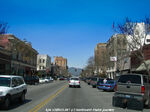
Downtown Wenatchee, WA. AJM STUDIOS Northwest Photo Journey.
Wenatchee is known as the "Apple Capital of the World" due to the valley's many orchards, which produce apples enjoyed around the world. The city is also sometimes referred to as the "Buckle of the Power Belt of the Great Northwest." The "Power Belt of the Great Northwest" is a metaphor for the series of hydroelectric dams on the Columbia River. Rock Island Dam is located nearest the middle of this "belt", and so was labeled the "Buckle". This saying is printed at the top of every issue of Wenatchee's newspaper, the Wenatchee World, and is no longer in common use elsewhere
History[]
Situated in a fertile valley in Central Washington at the confluence of the Wenatchee and Columbia Rivers, Wenatchee is the second most populous city in the central part of the state and serves as the Chelan County seat. To the south and west, mountains provide a dramatic backdrop for the City.
Years before Euro-American settlement, the area was inhabited by indigenous peoples who lived on the land. The Wenatchi were a nomadic culture and were closely bound to nature. They subsisted on salmon, roots, berries and nuts and interacted with other tribes.
The considerable amount of picturesque land available slowly attracted newcomers to the area. Beginning in ca. 1811, prior to permanent white settlement, nomadic fur traders of the British Northwest Fur Company (which later became part of the Hudson’s Bay Company) traveled through the upper Columbia River region, plying the waters of the great river and exploring the rugged wilderness for fur trapping and trading opportunities. The first non-Native American settlers were gold prospectors, Chinese miners, cattlemen, and missionaries.
The first “business house” was established in ca. 1867 by two men named Ingram and McBride. They operated a trading post in what is now Rock Island and conducted trading with the Indians. Other small businesses and a hotel soon followed.
Wenatchee’s population was 108 in May of 1891. By January of 1892, the population had increased to 300. The year 1892 was of great significance because of the Great Northern Railway’s decision to build its train depot about one mile south of Wenatchee, thus creating a new town.
Although located as a mid-point between Spokane and Seattle, the Wenatchee Valley was largely inaccessible because it is surrounded by mountains. Despite topographical limitations, the City's great potential as a productive agricultural region and business center did not go unnoticed. With this vision in mind, a group of Seattle businessman formed the Wenatchee Improvement Company in December 1890 to acquire property and build a town.
The Great Northern Railway would eventually help spur development of new towns and provide important transcontinental service for many communities along its vast route through the upper Midwest, northern Great Plains, and the Pacific Northwest. In early 1892, the Wenatchee Development Company, in close consultation with the Great Northern Railway, surveyed and platted the present site of Wenatchee. On May 6, 1892, this plat was filed with Kittitas County (Chelan County had not yet been created), and lots were placed on the open market the same month. Within five days, $100,000 worth of property was sold.
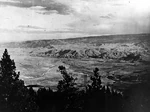
Overview of the Wenatchee Valley and town of Wenatchee. 1895.
By the late 1890s, Wenatchee was growing considerably and the need for a new county became clear. Ellensburg was the Kittitas County seat, but was separated from the Wenatchee Valley by a range of mountains. It proved inaccessible during the winter except via Spokane or Seattle by railroad, making it difficult for Wenatchee citizens to make the trek to Ellensburg for business purposes. The state legislature created Chelan County in 1899, carving it out of the existing Kittitas and Okanogan Counties.
By the late 1890s, the stage was set for Wenatchee’s economic and population boom. The Wenatchee Valley’s arid climate, rich volcanic soil, and proximity to the Columbia and Wenatchee Rivers proved to be an excellent combination for agricultural success.
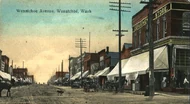
Wenatchee's downtown. Late 19th century photo, artificially colored.
Within a few years, the Valley was covered with row upon row of young fruit trees. Apples were shipped to all parts of the world, and more and more people, learning of ‘the valley of the apples,’ came here to stay. Within 25 years, Wenatchee became the center of the greatest apple-producing region in the world.
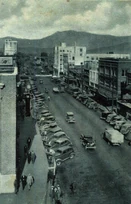
Downtown Wenatchee sometime between 1920 to 1945.
Although fruit-growing and its related industries dominated Wenatchee’s economy, other industries thrived as well. These included diversified manufacturing, farming, lumber, irrigation projects, some mineral development, steamboat transportation and shipping. Among these other enterprises, steamboat transportation and shipping were the most successful.
Wenatchee’s population steadily increased between 1910 and 1920 (from 4,050 to 6,324). By 1930, the population was 11,627, a gain of 5,303 people in 10 years, the most in its history up to that point. This boom reflected the City’s continued prosperity in agriculture. Cultural and civic development kept pace with industrial development, and all the fine institutions for a thriving community grew, including libraries, two daily newspapers, a good educational system, many churches, theaters, and a busy commercial district.
The City broadened its economic base after 1940 to include hydroelectric construction and electrical metal refining. The hydroelectric power created by the Grand Coulee Dam (completed in 1942) and Rock Island Dam (1932) made it possible for new industries to develop. The Aluminum Company of American (Alcoa) plant (1952) near Malaga, the Holden Mining Company at Lake Chelan (operated as the largest copper mine in Washington state from 1938 to 1957), and the Rocky Reach Dam (constructed in two phases in 1956 and 1969) were large employers in the area.
Currently, Wenatchee is the second largest City in Central Washington, drawing people from all over the region. The City experienced its largest population increase between 1990 and 2000, growing by more than 6,000 to a population of 27,856. Agriculture continues to play an important role in the economy and still provides a solid base.
Climate[]
Wenatchee's climate is warm during summer when temperatures tend to be in the 70's and very cold during winter when temperatures tend to be in the 30's.
The warmest month of the year is July with an average maximum temperature of 87.80 degrees Fahrenheit, while the coldest month of the year is January with an average minimum temperature of 23.20 degrees Fahrenheit.
Temperature variations between night and day tend to be moderate during summer with a difference that can reach 27 degrees Fahrenheit, and fairly limited during winter with an average difference of 14 degrees Fahrenheit.
The annual average precipitation at Wenatchee is 9.12 Inches. Rainfall in is fairly evenly distributed throughout the year. The wettest month of the year is December with an average rainfall of 1.52 Inches.
Geography[]
Wenatchee is located at the confluence of the Wenatchee River and the Columbia River in the Columbia Basin just east of the foothills of the Cascade Range. Unlike the climate of Western Washington, Wenatchee's climate is arid. Nested in the rain shadow of the Cascade Mountains, there are blue skies 300 days of the year. Technically a desert, irrigation from the Columbia River and her tributaries allows for the large amount of agriculture in Wenatchee and the surrounding areas.
The city of Wenatchee is bordered by the Wenatchee River on the north, the Columb ia River to the east, and the Wenatchee Mountains to the south and west. These high, rugged peaks form a wall around the western and southern sides of the city.
Although there are numerous jeep trails and forest roads out of Wenatchee to the south and west, most are too rugged to be passable by most vehicles. Because of this, the city of Wenatchee proper has only two entrances and exits which can be used by passenger cars; the North Wenatchee Avenue Bridge (North End Bridge) to the north, and the Senator George Sellar Bridge (South End Bridge) to the south. Once across these bridges, motorists can continue on to other points in the state.
While Colockum Pass is listed as a route out of Wenatchee (via the south end of the city on most maps produced by the Washington State DOT), and is a potential exit from the Wenatchee area, the route is clearly labeled as not being suitable for passenger autos, though its initial sections provide access to a railroad bridge at Rock Island and farther south the Rock Island Dam, both of which can be used in emergencies.
Another potential exit road leads north from the Mission Ridge ski area to an intersection with an unimproved road that extends west to US 97 (via the ghost town of Liberty) or north into Cashmere; again, this route is (when shown at all) marked as not suitable for passenger autos.
Because of the dangers involved in having only two points of ingress and egress into the city during an evacuation, not to mention traffic congestion, officials have mentioned the possibility of additional bridges potentially being designed in the future over the Columbia or Wenatchee Rivers, as reported periodically by the Wenatchee World.
Districts and their Neighborhoods[]
Appleyard
Downtown
Olds Station
West Wenatchee
Culture[]
Wenatchee is home to many music groups including The Wenatchee Valley Symphony, Wenatchee Big Band, Columbia Chorale, and The Apollo Club. The Music Theater of Wenatchee and Mission Creek Players present quality theatrical productions and musicals. Wenatchee also boasts the Mariachi Huenachi Band and a renowned mariachi program in the Wenatchee School District.
Recreation[]
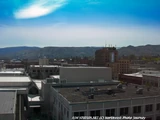
Overlooking downtown Wenatchee. AJM STUDIOS Northwest Photo Journey.
The Wenatchee Valley and the surrounding areas provide an abundance of sports and recreational activities for any season. There are several facilities including the tennis club, an Olympic size swimming pool, an ice arena, several 18-hole and 9-hole golf courses, a 9-hole disc golf course, and countless baseball diamonds and soccer fields. There are lots of places to hike, fish and hunt, both birds and larger game. Boating and water recreation are also quite common. Many kayak, windsurf and water-ski on the Columbia. Whitewater rafting and inner-tubing is frequent on the Wenatchee River. In the winter, the mountains near Wenatchee provide great snowmobiling, sledding at Squilchuck State Park, as well as skiing and snowboarding at Mission Ridge (30 minutes drive) and Stevens Pass (1 hour and a half drive). Nordic skiing is available at the Stevens Pass Nordic Center, Leavenworth (25 minute drive), and the Methow Valley (1 hour and 45 minute drive).
The city also offers a large system of parks and paved trails known as the Apple Capital Recreational Loop Trail. The 10-mile (20 km) loop which runs both banks of the Columbia River is used by cyclists, walkers, joggers, and skaters. In the winter cross country skiers and snowshoers also use the trail. The trail connects in the south at the Old Wenatchee-East Wenatchee Bridge, better known as the walking bridge, and in the north at the Richard Odabashian Olds Station Bridge. Much of the hillside areas surrounding the city of Wenatchee have been purchased by or have their rights held by the Chelan-Douglas Land Trust which protects them as a natural resource and as a site for hiking in the foothills. The foothills trail system along the western edge Wenatchee provides numerous short trails of varying difficulty for walking, hiking and mountain biking.
Media[]
Television
KWCC-LP
Newspapers
Nickel Ads
Wenatchee Business Journal
Wenatchee World
Sports[]
Baseball: WCL: Wenatchee Applesox
The Wenatchee Applesox were founded in 2005, during the inaugural year of the the West Coast League, an independent summer baseball league. The team features top college players and prospects and has even had several former players play their way onto the rosters of Major League Baseball teams. Their season typically lasts through the summer. The Applesox won the league championship in 2005, 2006, and 2009.
Football: WFL: Wenatchee Valley Rams
The Wenatchee Valley Rams were founded in 2005 and are members of the Washington Football League. The team plays its home games at Wildcat Stadium in East Wenatchee. The games are usually scheduled March through May, with the postseason to follow. In 2009, the Wenatchee Valley Rams won their league championship.
Soccer: PASL: Wenatchee Fire FC
The Wenatchee Fire play indoor soccer as members of the Professional Arena Soccer League. The team has experienced a great deal of success during their time of operation. The games are played at the Wenatchee SportsPlex facility, located in Wenatchee.
Hockey: NAHL: Wenatchee Wild
The Wenatchee Wild are members of the North American Hockey League and play their home games in the Town Toyota Center in Wenatchee. The team's first year in the city was 2008 and though they were an expansion franchise that season, they won their division and came in 2nd in the league after losing in the championship series.
Indoor Football: AIFA: Wenatchee Valley Venom
The Wenatchee Valley Venom are a new team that plays in the Town Toyota Center in Wenachee. The team plays indoor football and is a member of the American Indoor Football Association (AIFA).
Infrastructure[]
Health systems[]
Wenatchee has two major hospitals. The Central Washington Hospital and the Wenatchee Valley Hospital.
Crime[]
Wenatchee is serviced by the Wenatchee Police Department and the Chelan County Sheriff's Department.
Transportation[]
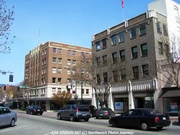
South Wenatchee Avenue is a main thoroughfare through downtown. AJM STUDIOS Northwest Photo Journey.
The city is served by Pangborn Memorial Airport with flights to/from Seattle on Horizon Air. Pangborn Memorial Airport is a public use airport in Douglas County. It is located four nautical miles east downtown of Wenatchee, in Chelan County. The airport is owned by the Ports of Chelan and Douglas Counties. On average annually, the airport has 44,681 aircraft operations.
Pangborn Memorial Airport is named for Clyde Pangborn, who in 1931 became the first person to fly non-stop across the Pacific Ocean. Taking off from Misawa, Aomori, Japan with an intended destination of Seattle, he instead landed in Wenatchee.
Wenatchee is in the major railroad line of the Great Northern Railway (now BNSF Railway) to Seattle. It was once the eastern terminus of the Great Northern's electric operations (1928/1929-1956) on its New Cascade Tunnel route via the Chumstick Valley, which went all the way to Skykomish. Here, steam or diesel locomotives were changed or coupled to electric locomotives for this route. Today, Amtrak's Empire Builder serves the city.
Major roads and highways weave around and through the city. Highway 2 connects the city westbound to the Puget Sound city of Everett.
